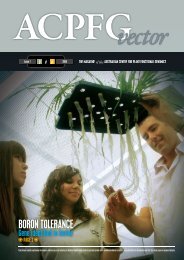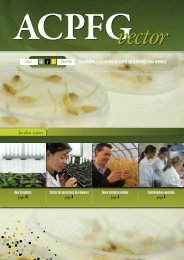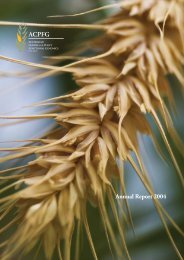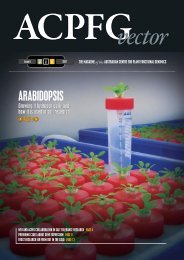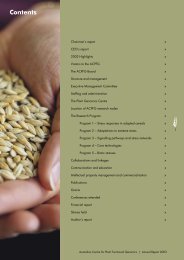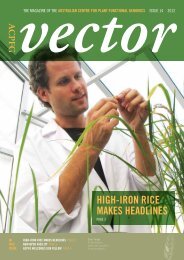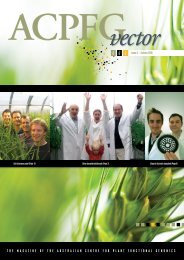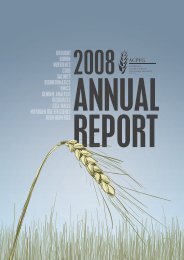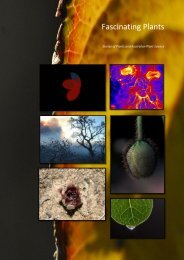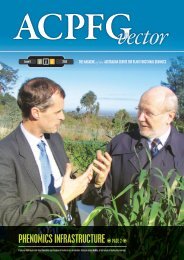ACPFG Annual Report
ACPFG Annual Report
ACPFG Annual Report
You also want an ePaper? Increase the reach of your titles
YUMPU automatically turns print PDFs into web optimized ePapers that Google loves.
Technology Platforms<br />
Whilst extensive phenotyping of the population has not been<br />
possible with current staffing levels, it is apparent that there<br />
are a number of mutants with altered phenotypes when<br />
compared to wildtype material. For these lines we have begun<br />
analyses of Ds insertion sites through generation of flanking<br />
sequence tags.<br />
Barley TILLING population<br />
We generated a barley targeted induced local lesions in genome<br />
(TILLING) population in 2007, by ethane methyl sulfonate (EMS)<br />
mutagenesis of 10,000 barley (cv. Flagship) seeds. We sowed<br />
500 M1 families of ten individuals, grew the plants to maturity<br />
and documented any obvious mutant phenotypes. Seed from<br />
individual plants was retained for further plantings and pooled<br />
leaf tissue was taken for DNA isolation from the three healthiest<br />
family members. Four thousand M2 families, consisting of<br />
three individuals, were planted. DNA is being extracted from<br />
all individuals and will be stored for characterisation of DNA<br />
lesions. The seed that forms the mutant population is now ready<br />
for screening.<br />
Genome Structure Resources<br />
We have now completed two large insert barley (var. Morex)<br />
HindIII BAC libraries, as part of the international barley<br />
physical mapping project. One contains 115,200 BAC<br />
clones, with an average insert size of 115 kb, while the other<br />
contains 153,600 clones, with an average insert size of<br />
143 kb. Together, these two libraries cover approximately six<br />
equivalents of the barley genome. In 2007, we produced a<br />
BamHI BAC library with an average insert size of 120 kb. This<br />
library contains 300,000 clones and covers seven equivalents<br />
of the barley genome. We produced eight filter copies for<br />
hybridisation screening of the barley HindIII BAC library, as<br />
well assix filter copies for hybridisation screening of the rye<br />
HindIII BAC library, and four filter copies for hybridisation<br />
screening of the phalaris HindIII BAC library.<br />
In addition to the barley BAC libraries constructed, we also<br />
helped colleagues at CSIRO Plant Industry construct a lupin<br />
BamHI BAc library. This library contains inserts around 100 kb<br />
and has ten times genome coverage.<br />
Promoter isolation<br />
Promoters are DNA elements that are important in the<br />
spatial and temporal control of gene expression in an<br />
organism. Scientists use these promoters in the production of<br />
constructs for plant transformation, so that the transgene can<br />
be expressed in specific tissues, at specific developmental<br />
stages, or in response to specific stress treatments. We isolated<br />
promoter elements from Arabidopsis and rice enhancer trap<br />
lines, and for Arabidopsis we were able to replicate the<br />
patterns of cell-specific gene expression seen in the lines from<br />
which the promoters were isolated. In addition, we isolated<br />
promoters from rice and wheat. Five of the rice promoters<br />
enabled drought stress inducible expression of a reporter<br />
gene in transgenic barley, and another cold stress inducible<br />
expression. We also modified three transformation vectors for<br />
use in the plant transformation process.<br />
Heterologous Expression<br />
As a result of funding priorities for <strong>ACPFG</strong> II changing,<br />
support for this technology platform ceased in 2007. Several<br />
heterologous expression techniques have been implemented,<br />
including the magnICON system developed by ICON Genetics.<br />
A number of genes were expressed in Nicotiana benthamiana<br />
leaf tissue using the magnICON system and were extracted and<br />
found to be active. These included the control GFP and the cell<br />
wall modifying enzymes EII, XEB and XTH.<br />
Proteomics and<br />
protein analysis<br />
APCFG’s proteomics platform is located at the School of<br />
Botany, University of Melbourne node. Protein abundance<br />
and activity can be regulated through multiple mechanisms at<br />
the level of gene transcription, translation, post translational<br />
modification and protein degradation. In 2007, methods have<br />
been refined to enable quantitative comparisons between<br />
protein abundance in different tissue extracts. Robust<br />
capabilities were established using two complementary<br />
approaches to undertake this type of experiment; two<br />
dimensional gel electrophoresis coupled with difference in gel<br />
electrophoresis (DIGE) dyes and iTRAQ peptide labeling.<br />
The iTRAQ methodology was successfully applied to the<br />
comparison of protein abundance in B tolerant and intolerant<br />
barley lines, and this resulted in a publication in Plant<br />
Physiology. This approach was also applied to examining the<br />
changes in protein abundance in the roots of barley plants<br />
following salt stress. This study highlighted consistent changes<br />
in proteins involved in glycolysis following extended exposure<br />
to elevated salt, and the physiological implications of this are<br />
being investigated.<br />
The 2D-DIGE was used to monitor changes in protein<br />
abundance in rice suspension culture cells, following<br />
exposure to elevated levels of NaCl and abscisic acid. A<br />
number of proteins with altered abundance have been<br />
identified following these treatments. Coupled with these<br />
studies have been the ongoing identification of proteins from<br />
2D gels and the construction of 2D spot libraries. To date,<br />
over 100 spots have been identified in reference 2D gels.<br />
We also used the targeted analysis of simple protein mixtures<br />
to identify the post-translational modification status of a<br />
number of thioredoxin proteins. These targeted studies have<br />
been used as a preliminary component of the antibody<br />
production pipeline, to monitor the efficacy of protein antigen<br />
expression levels.<br />
30



